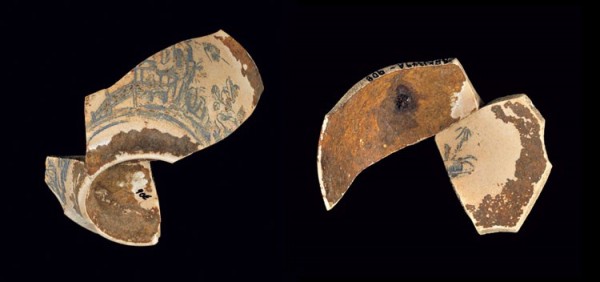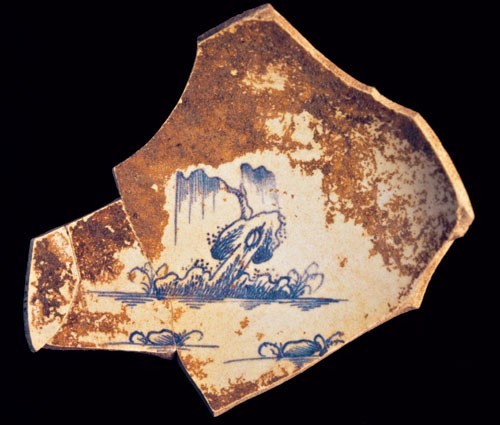
Teabowl fragments, John Bartlam, Cain Hoy, South Carolina, 1765–1770. Soft-paste porcelain. (Courtesy, South Carolina Institute of Archaeology and Anthropology; photo, Stanley South.) This painted decoration occurs on several teabowls and was dubbed “Bartlam on the Wando.” A sherd from a similar teabowl is overlain for comparison, to show the similarities in the painted design.

Teabowl fragment, John Bartlam, Cain Hoy, South Carolina, 1765–1770. Soft-paste porcelain. (Courtesy, South Carolina Institute of Archaeology and Anthropology; photo, Gavin Ashworth.) Note the deteriorated glaze resulting in a thick brown patina found on many of the Bartlam porcelain fragments. This material was carefully scraped away to reveal the underlying blue decoration.

Teabowl fragment, John Bartlam, Cain Hoy, South Carolina, 1765–1770. Soft-paste porcelain. (Courtesy, South Carolina Institute of Archaeology and Anthropology; photo, Gavin Ashworth.)

Teabowl fragment, John Bartlam, Cain Hoy, South Carolina, 1765–1770. Soft-paste porcelain. (Courtesy, South Carolina Institute of Archaeology and Anthropology; photo, Gavin Ashworth.)

Teabowl and saucer fragments, John Bartlam, Charleston, South Carolina, probably 1771–1773. Soft-paste porcelain. (Courtesy, Charleston Museum; photo, Stanley South.) These fragments excavated from sites in Charleston exhibited the same characteristic brown patina as Bartlam’s Cain Hoy porcelain. It is probable these examples were made at Bartlam’s “POTTERY and CHINA manufactory” in Charleston, which appears to have operated between 1771 and 1773, before he moved to Camden.

Teabowl fragment, John Bartlam, Cain Hoy, South Carolina, 1765–1770. Soft-paste porcelain. (Courtesy, South Carolina Institute of Archaeology and Anthropology; photo, Gavin Ashworth.)

Bowl fragment, John Bartlam, Cain Hoy, South Carolina, 1765–1770. Soft-paste porcelain. (Courtesy, South Carolina Institute of Archaeology and Anthropology; photo, Stanley South.)
